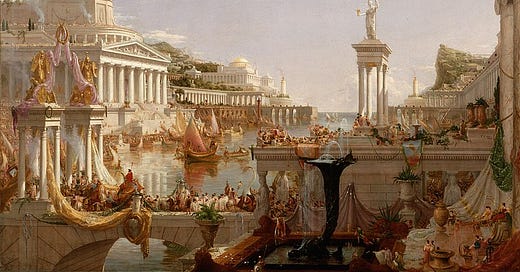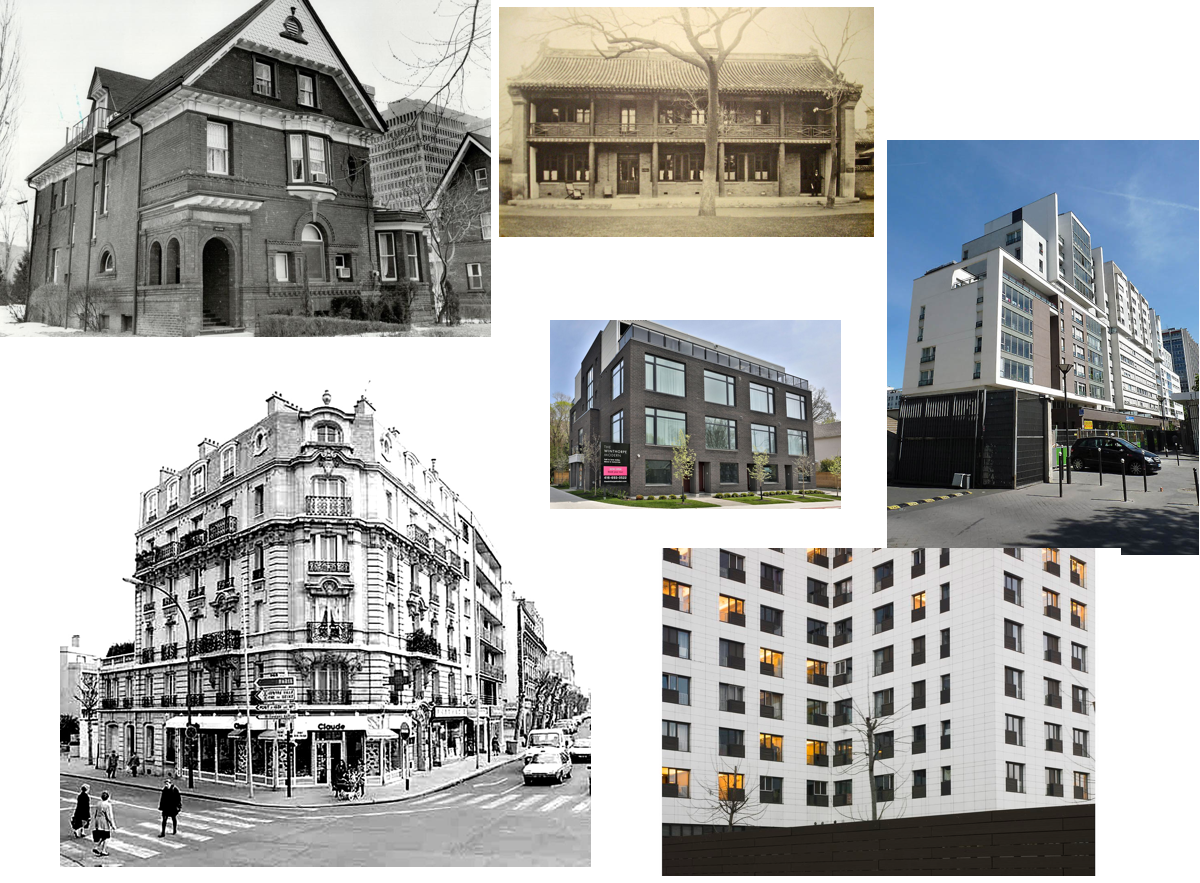Homogenous Culture in the Global Village
Our shrinking world leaves us little room to innovate
Our Current Cultural Sameness
Our culture has become increasingly repetitive.
To get a sense of how this operates look at the collage of images below. The top left image is of a house in Toronto, to its right is a house in Beijing and below it a block of apartments in Paris. All were built around the turn of the 20th century. The other three images are of residences built in the same cities in the last twenty years. Can you tell where each one is?
Somehow the world over we have all come to value the same set of cultural forms that avoid distinct and inventive features.
One way I think about this is in terms of gothic cathedrals. Most people would accept that it is uncommon for our culture to produce something that is in relative terms as grand, imposing and culturally significant as the cathedrals were in Medieval Europe. But, building something innovative is even more difficult than building something grand. The gothic cathedrals appeared out of thin air, and apart from some basic structural elements that were borrowed from the prior Romanesque style, they looked nothing like what came before. It’s hard to imagine our society making such a leap.
Another way you can see the problem is by looking at the art we consume. Of the top five highest grossing films of the last 20 years, four come from franchises that had been created before the 1980s (Marvel and Star Wars).
The source of this cultural stagnation is overdetermined. Trying to piece out a single cause that led to the current state of affairs is a fool's errand. Though, we may be able to point to some of the vectors involved.
One that may at first appear counter-intuitive is the impact of globalisation.
The Tension Between Globalisation and Cultural Innovation
In short: To pursue cultural innovation we need to experiment and invest in new, distinct, cultural forms. Globalisation works against the creation of these forms in at least two different ways. First, by flattening the evolutionary landscape that forms can developed in; and second, by placing us all in a single mimetic game of competition.
The first mechanism operates by analogy to evolutionary processes.
New species evolve to fit specific niches in an ecosystem. As such, the diversity of species is driven by the diversity of available niches. The great multiplicity of plants and animals on Earth exist precisely because of the great variety of environments around the globe. Rainforests, grasslands, mountains, oceans and lakes act as the substrate responsible for producing the ecological variety we experience.
Culture arises similarly. In a world with a wide variety of different contexts for culture to form, you would see many cultures developing. When you have different mediums for the dramatic arts, you see a corresponding variety of drama. Shakespeare's London with its standing-room-only theatres South of the river created one kind of drama. Street gatherings in Korea during the Chosŏn dynasty produced another.
When every person in the world can access drama through the same streaming service on their laptop, the content we consume becomes identical.
The second mechanism is the result of humanity’s particular nature.
Humans are driven to copy one another. When we gather together we naturally come to desire the same things and act in the same way to try and acquire them1.
You can see this play out on college campuses, at workplaces, and in political parties. When people operate in shared spaces, the goals of individuals inevitably recede into the goals of the group. Everyone looks to get the same job in the same set of prestigious companies or the same set of limited promotions. To achieve these aims people adopt specific scripts: dressing, speaking, creating, and valuing a certain way.
For most of human history this process may actually have improved our cultural inventiveness. We mimicked the people around us, but the group was limited to people within relatively small geographic, linguistic regions. Across the globe this meant a huge variety of villages, campuses, companies and social circles all experimented with their own mimetic cultural games, often pursuing them into strange side branches of innovation.
However, as our world has become increasingly small, the group of people copying each other become larger and larger. Now everyone can compare their aesthetic tastes not only to the most popular person in their class, but to the most popular model on Instagram.
A perfect example of how this global mimicry works is the International Airbnb Style that has slowly taken over interior decorating around the globe. Having a single platform that can be used to assess the tastes of all international travellers allows every interior decorator to develop an ever more precise sense of what will fit the majority of people’s needs. It is not that the style is bad per se. It is comfortable, high-'quality', perhaps even a bit quirky but it lacks any kind of distinction. Ultimately, building a global village simply won't work to create cultural diversity.
Paths Forward
Of course a world that did not have to deal with a flat cultural landscape or global memetic competition will not immediately be thrust into a space of universal cultural flourishing. Not all new ideas will be good. In fact many will be boring, crass and ugly. Nonetheless, some may succeed. And if we want to have new ideas at all we need to be able to differentiate. Increasing global connectivity will always make this more difficult.
There are no easy answers for how to get past these problems. As described at the beginning of this essay, our cultural stagnation is overdetermined. Simply throwing globalisation into reverse will not lead to a cultural renaissance. Moreover, a world of hard borders and completely distinct groups with no ability to communicate is both out of reach and ultimately undesirable. Some degree of globalisation is inevitable and perhaps even wonderful2. Yet, we would be wise to consider the impacts such a shortening of distances has on our shared cultural riches.
Thanks to Casey Li for reading a draft of this essay
Links and Reviews
The Decadent Society by Ross Douthat
It is a basic assumption for many people today that we are experiencing a kind of broadly distributed progress across scientific, technological, economic, and cultural domains. However, this picture is not as vivid as it once was. The lacklustre response to the COVID pandemic by governments across the globe, combined with the increasing public awareness of the collapse in birthrates, and the endlessly recurring saṃsāra3 of US political debates have strained these assumptions.
A contrary belief that we may in fact be in a period of prolonged stagnation is expressed forcefully by Ross Douthat in his 2020 book, The Decadent Society. In the book, Douthat charts the slowdown in economic productivity, declining birthrates, political incompetence, and cultural repetition that have become ever more prevalent over the last 50 years. These point to a stagnant society. As Douthat describes it, this is not necessarily a society that is on the brink of collapse, but it is one which has settled into a comfortable decadence, happy to imagine a progress that is no longer evidenced by its operation.
By “decadence” [Douthat] does not mean delicious sensuality or over-the-top indulgence… but stagnation and complacency, a dissipation of creative energy, a jaded will merely to muddle through.
- Peter Thiel’s review of the book for First Things
If you are skeptical of these claims I would highly recommend the book. In general we probably should be skeptical of any apocalyptic or utopian takes on the nature of society at large. However, the book makes a very compelling case that we are overly optimistic about the current state of things. We should approach the situation with more urgency than we currently give it.
René Girard called this drive mimesis.
I live in Canada where one aspect of globalisation, large scale immigration, has been and hopefully will continue to be a huge source of wealth and dynamism for our society. The point is not to condemn the process of globalisation but to be wary of the negative side-effects. Simply relying on ever greater numbers of immigrants will not only not produce a flourishing culture but it may serve as an impediment to it. We need to actually aim at something if we want to develop unique cultures.





Arturo, this is a really interesting perspective. Thank you.
Overall, my sense is that this specialization is harmful to fecundity. Yes our creations may be more streamlined, smooth, efficient, and scaled but we are poorer (less full of life) for the lack of diverse, local, and specific centres of cultural production.
It’s like an old growth forest that’s been cut down to create a field of wheat. Maybe the wheat has a lot of calories and has been turned into a hyper efficient way to create biomass. But, the lack of biodiversity ultimately makes it fragile, not to mention lacking in beauty.
Hey Ben great thought piece! I think you hit the nail on the head when it comes to globalization's impact on cultural innovation.
I do think, however, that cultural innovation, much like technological innovation, has become more specialized and more streamlined, and is become less diverse and localized. I think whether that's good or bad is up for debate.
I spent quite a bit of time tracing the origins of cultural innovation, whether it's aesthetics, architecture, culinary or management methodologies, it seems to me that even in present day, the majority of cultural innovation still happens in a handful of cities like London, New York, Paris, Los Angeles, Milan, Miami and Tokyo. What is different between the present and the past of cultural propagation, is that cultural trends now propagate so fast that within two years the trends set in the world's alpha cities have propagated to pretty much every corner of the earth.
It could be construed as a dangerous phenomenon considering this means less glamorous local cultures got work cut out for them just to stay alive and not be drowned out. But at the same time, hey, if the local cultures are strong enough, it could very well make their way to the alpha cities and then propagate out internationally. Latin Music and Muay Thai are great examples of local cultures that gained international prominence.
The reason why I don't think this "homogeneity" is not necessarily a bad thing when the global community can engage in common activities historically only celebrated in Latin America and in Thailand. This streamlining of cultural growth potential makes innovation faster, but yes, by sacrificing diversity.
Anyway it's an interesting topic. looking forward to reading more from you! Take care!